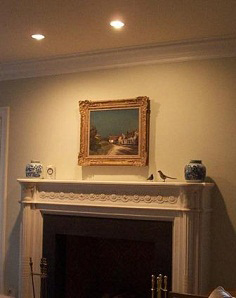Lumens per Watt: the “MPG” for lighting in your new renovation
What kind of lighting should you use in your home renovation? There are a number of factors: the looks of the light fixtures, the ideal amount of light for a given task, even the color and direction of the light itself.
One factor to consider is how much light you get for the electricity you buy. There’s a big difference between the worst and the best performers.
Engineers measure the efficacy of lighting in lumens per watt (lm/W). “Lumens per watt” is very much like miles per gallon in a car: more lumens per watt  means you’re getting a better deal.
means you’re getting a better deal.
Incandescent & halogen bulbs: low “mileage”
Traditional incandescent light bulbs create between 12 and 18 lumens for every watt. Halogens are just a little better, ranging up to 22 lm/W.
That’s an abysmal ~10% of the electricity converted into light! All the rest of the energy is converted into heat. During the summer, that waste heat has to be removed from your house by your air conditioner, at considerable expense! In winter at least you want the heat, but it’s three times the price as heat from your furnace.
Fluorescents: efficient, but imperfect
Fluorescent lighting is generally much better. Compact fluorescent bulbs (CFLs), the curlicue style that fit in most ordinary fixtures, feature lm/W ratings in the 40-60 range. That’s around four times as much light for the same electricity. So, a thrifty 13 watt compact-fluorescent bulb puts out about the same lumens as a 60 watt old-fashioned bulb.
There are downsides to fluorescents, of course:
- While the light color has been improved, it’s still far from perfect. Older, “cool white” fluorescents have a Color Rendering Index (CRI) of 60, but the “warm white” fluorescent bulbs available these days are a much nicer 85. Still, the artists and photographers in your family can tell the difference.
- Fluorescent bulbs contain mercury, which is a toxin. It’s safely contained within the bulb unless the bulb breaks. I know in my house we broke only one of about 40 compact fluorescents in ten years, a reasonably good record, but it is a legitimate concern. Also, they have to be disposed of in a special hazardous waste collection.
- Only specially-made fluorescents can be dimmed. Also, ordinary compact fluorescents will die early if used in fixtures where the base gets hot. If you shop around, you can find dimmable fluorescents, and also special versions for recessed downlights and enclosed fixtures where heat builds up.
LEDs: the future of lighting?
LED lighting has the potential to overcome all these downsides of compact fluorescents, with the same high “mileage” ratings. In fact, there are already LED lights on the market right now that deliver more lumens where you want them, have great color, and price out competitively, at least in the long run.
The best LEDs are really great. They are as efficient as compact fluorescents, with better color. They come on immediately with no warm-up period and are dimmable. While the price up front is more, they last longer and use less electricity, and in the end are much cheaper than incandescents.
Careful shopping is in order, as the LED market is definitely a mixed bag right now. Some LEDs on the market are dim, have terrible color, are inefficient—or all three! Using what we know about lm/W, CRI, and verifying manufacturer information through Department of Energy testing, we have been able to find the winners on the market.
We have installed LED recessed downlights from North Carolina-based CREE on several projects. Besides a very high 60 lm/W rating, they provide an even, warm, diffuse light that one client says is especially nice in the morning, as they prepare breakfast in their kitchen.
The best part for one of our clients came when they called our Customer Service team to ask how to replace the LED light bulb, should one go out. Imagine the pleasant surprise when we calculated the replacement timeframe: at 6 hours use every day, it will be about 13 years before they need a replacement; at 3 hours a day, 26 years! And, they’re saving money on electricity every day.
A client who is a fine-art photographer didn’t like the LED lights because they change color a bit when they are dimmed. That was before special adjustable dimmers were available for LED lighting, so it may be a solved problem at this point, but it’s something to be aware of.
CREE lights are a bit expensive up front. Compared to traditional recessed lights they add maybe $20-50 per light. But, they last as long as 15 or more $3 floodlight bulbs, so the bulb cost is about even. Each one saves about $15 in electricity per year, so a kitchen with ten can save you $150 a year, nothing to sneeze at; plus no bulb changes for over a decade, and you’re saving the pollution from the electricity you didn’t need.
OTHER POSTS
